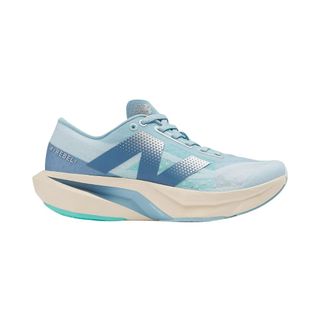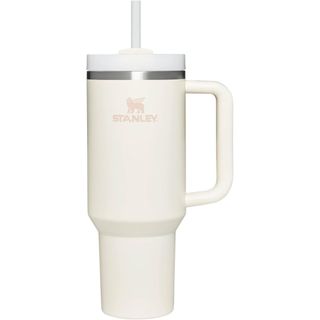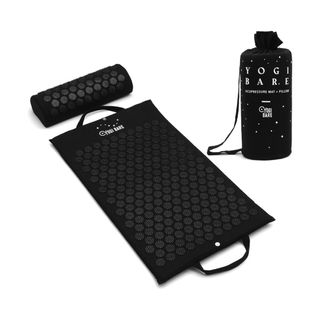I'll let you in on a little secret. Despite being a Health Editor with nearly ten years of experience under my belt, I have a bit of an aversion to fitness challenges. While some can be motivating and help you to reignite your passion for movement and wellbeing, I find the vast majority of them impossible to stick to, too generalised to see any legitimate results, or invented by a content creator without the relevant qualifications. That was, of course, until I stumbled across the trending "Winter Arc" challenge.
Brought to my attention by Team MC's savvy Social Media Editor, Dionne, the premise of the challenge is simple: to use the colder months from now until Christmas to prioritise your health and wellbeing, using the change of season as a catalyst for - yep, you guessed it - change.
Unlike other fitness challenges I've seen doing the rounds this year (I'm looking at you, 75 Hard), the winter arc isn't prescriptive. There are no rules and you don't have to cut anything out, rather, it's about leveraging the colder months to lock in habits that make you feel good, physically and mentally. Approaching healthy living joyfully and mindfully, the challenge encourages you to cement a healthy routine - the idea being that, come the new year, when you're hit with the onslaught of "New Year, New Me" messaging, you're already in a healthy and regular routine.
I've been trying my very own winter arc challenge since the start of October and can't tell you how much calmer, healthier and happier I feel in both body and mind. Curious about the new trend and keen to see if it might be one for you? Below, two top personal trainers share more, plus I share my review, one month in.
I'm normally anti fitness challenges - but the winter arc has me well and truly sold
What is the winter arc challenge?
According to Lucie Cowan, personal trainer and Cycle Master Trainer at Third Space, "the winter arc challenge is a trending concept that encourages people to focus on self-improvement throughout the fall and winter months rather than waiting for New Year’s resolutions."
In essence, it's all about embracing the colder months as an opportunity to prioritise both exercise and mental health, adds personal trainer and KXU coach Louis Quaye. "Instead of slowing down, it promotes staying active despite the challenges of colder temperatures and reduced daylight hours," he goes on.
@lenalifts ♬ original sound - lenaWhere did the winter arc challenge originate from?
According to Quaye, the concept is inspired by practices from colder Nordic countries, where outdoor activities during harsh winters are common. Cowan adds: "It's gained popularity on TikTok in 2024, largely driven by fitness and wellness influencers and inspired by the idea of character arcs in fiction."
What does the winter arc involve?
You're clued up on what the winter arc challenge is. Now, question: what could it actually look like for you?
The beauty of the challenge is that it's meant to be tailored to you, your personal goals, and your preferred lifestyle. As an example, you could choose any of the following and aim to do them each week before the end of the year.
- Committing to daily exercise
- Aiming for eight hours of sleep
- Eating protein and vegetables with each meal
- Drinking two litres of water
- Practicing daily mindfulness
- Avoiding screens before bed
- Starting the day with some sunlight
- Reading ten chapters of your book a day.
That said, the possibilities really are endless. If you know you feel best starting each day with a relaxing yoga flow, you do you. If you're more of a high intensity person, you might like to add some circuit workouts to your weekly rotation.
@abbiedennisonfit ♬ its ok im ok sped - Tate McRaeWhat are the benefits of doing the winter arc?
As Cowan points out, there are loads of benefits to giving the challenge a go, including improved discipline, physical health, and mental clarity. Plus, did you know? "Research suggests that forming habits during colder months can be particularly effective due to fewer social distractions," she goes on. "One paper published in The European Journal of Social Psychology found that forming habits takes an average of 66 days, making winter a good window to focus on new routines."
1. Boosted physical health
Naturally, if you're making more time to exercise regularly, you'll likely notice an improvement in your general fitness - especially in the colder months, and not just because that's the best time to make a habit stick. "Regular exercise during the colder months can improve cardiovascular health and strengthen the immune system," explains Cowan.
Case in point: one study from the Journal of Sports Science found that maintaining a workout routine during winter reduces the risk of heart disease.
2. Better sleep
Establishing a healthy sleep routine is a key element of the winter arc, shares Cowan, and there's plenty of evidence to prove that increasing both the quality and duration of your sleep can only be a good thing. "Research published in the Sleep Medicine Review journal shows that improved sleep hygiene can reduce stress and enhance overall well-being," shares the expert.
3. Enhanced mental clarity
Being consistent with your routine has been found to boost mental wellbeing and improve focus, too. "Studies from Harvard Health indicates that mindfulness can significantly lower anxiety and depression, promoting mental clarity," explains Cowan.
4. And lower stress levels, too
Last but by no means least, committing to wellbeing practices during winter can alleviate the stress that often accompanies this season, shares the trainer. "A study in The American Journal of Lifestyle Medicine found that consistent self-care and stress management techniques can lower cortisol levels and improve mood," she concludes.
That said, Cowan does warn that it's important not to set goals that are unrealistic or too demanding, as you'll risk burnout. Pair that with the increased risk of Seasonal Affective Disorder (SAD) in winter, which can exacerbate low mood or energy and make it harder to stick to a routine, and you'll see that the winter arc isn't for everyone.
Bottom line: It's important to remember that life is all about balance, and if the challenge does start to feel too prescriptive, then it might not be for you. Take note of how you're feeling each day and make sure to acknowledge if it's feeling overly demanding or like it's promoting toxic productivity at any point. Nothing is more important than your general wellbeing, after all.
Who should try the winter arc challenge?
Anyone and everyone, but particularly fitness enthusiasts who are looking to maintain or enhance physical health, shares the PT. "It's also great for anyone wanting to establish long-term, productive habits before the New Year," she goes on.
Quaye agrees, adding that he'd recommend the winter arc to anyone looking for a fitness challenge or a way to stay active during the colder months. "It’s particularly helpful for those who want to combat winter-related mood dips," he concludes.
I tried the winter arc challenge - and can't tell you how much it's boosted my mental and physical health
Weeks one to two
At the start of October, and after one of the busiest summers of my life, I knew I was desperately in need of some time at home focusing on my physical and emotional wellbeing. While I'd maintained a good base level of fitness over the summer months, strength training from home, running to work and heading to my local Parkrun when I could, I'd been travelling a lot, meaning I'd eaten a lot more service station meals than I cared to admit.
Pair the inconsistent nutrition with a spotty sleep routine and I was excited to reset this autumn, prioritising the habits and routine that make me feel my best.
So, when the winter arc popped up on my TikTok FYP, my interest was piqued. After watching a few videos, I sat down with my wellness journal to lay out some guidelines. These were by no means rules - I'm of the opinion that lifestyle "rules" can be just as harmful as diet fads. Rather, they were guidelines to aim for every day that looked like:
- Daily movement, whether that be 10km steps, a run, or strength training
- Nutrient-dense meals centred around protein and fibre
- 2 litres of water a day
- No screens and ten pages of my book before bed.
Around about the same time, I was offered a Valencia Marathon place which really helped me to kick-start my new routine. Having an end goal - aka the marathon to run at the start of December - made me prioritise my training miles, fuelling my body adequately for the distance and getting enough sleep to allow my body to recover, too.
Two weeks in, and having banked 30 to 35-mile training weeks, eaten plenty of nutrient-dense meals, and nailed my sleep routine, I was feeling better than I had in months. My focus was clearer, I felt happier, and I found I was responding to stressful situations more calmly. Two weeks down, seven to go.
Weeks three to four
Come the second half of my October challenge and, in line with my marathon training plan, my mileage ramped up quite significantly. Week four included a strength training session, two five-mile easy runs, a nine-mile speedwork session, and an 18-mile long run. I've trained for and run nine marathons before, but that's not to say I don't still find the distances intimidating sometimes.
That's where the new routine really came into play. By going to bed earlier, I found getting up in the mornings to bank my mileage easier, plus found myself looking forward to my sessions with a renewed sense of purpose. Making this commitment to my health and wellbeing meant keeping my weekends largely free, bar one or two social events, which was also a welcome break from the back-to-back weddings and 30th celebrations of the summer.
While I've still got some way to go until the end of the year, I've been really pleased with how much better I've felt both mentally and physically since deciding to give this challenge a go. Sure, it won't be for everyone, but if you are at a point where you're keen to focus on yourself and your wellbeing for a couple of months, without the pressure of strict rules or pointless restrictions, then the winter arc could be for you. For me, it's been a welcome break after what's been a chaotic few months where, often, my health took a back seat.
Now, question: will you be giving it a go?
Shop the products I've been using to support me through my winter arc here:

New Balance FuelCell Rebel v4 Shoes
I've been testing these trainers from New Balance for a few months now and really rate them as a stable, trustworthy and springy training shoe. They never run, are easy to slip on, and help you feel confident with every stride. Do note, though: They run a little small, so do go up either half or a whole size.

I find staying on top of my hydration way easier when I have a visual cue or reminder in front of me - which is where the viral Stanley Quencher comes in. This design comes in a range of colourways and holds a handy 1.2litres of water.

Yogi Bare Acupressure Mat
As part of my evening winddown routine, I've been rolling out my acupressure mat for ten to fifteen minutes while I read my book in bed. It's seriously relaxing, helps alleviate sore or tired muscles, and boosts relaxation before you drift off. What's not to love?




















 English (US) ·
English (US) ·